CHAPTER 3. Restoration of the World Heritage Site Kizhi Pogost in 2013
 @kizhi
@kizhi
3.1. General information
In 2013, the development of the design estimate documentation and the restoration of the Church of the Transfiguration was going on.
Just like previous years, the work performance was granted on the basis of a competitive tendering. Two contractors, and namely „Alekon“ Co ltd and „Zaonezhie“ Co ltd remain in this restoration project as the result of the competitive tendering, and a new General designer since 2013 is „Georeconstruktsiya“ Co ltd. The Design work performer of many years remains „Spetsprojectrestavratsiya“ Institute (Moscow) which continued the work as a subcontractor.
In 2013, the following restoration works were performed on the Church of the Transfiguration in line with the contracts made:
- test-assembling of the 6th restoration tier in the Restoration Complex was completed as well as the restoration and final assembly on the Pogost; test-pressure on the logs was applied by the means of calibrated lifting jacks (done by the contractor „Zaonezhie“ Co ltd);
- the reconstruction of the church stone foundation was completed (done by the contractor „Alekon“ Co ltd);
- the disassembling of the 4th and 5th restoration tiers was started and is going on in 2014 as well (done by „Alekon“ Co ltd);
- the restoration of the 4th and 5th restoration tiers and test-assembling in the Restoration Complex was started and is going on in 2014 (done by „Zaonezhie“Co ltd);
- the reconstruction and disassembling of specific parts of the lifting equipment and of the metal structure supporting the church was continued (done by „Alekon“ Co ltd).
A reliable team and year-round production made it possible to fulfill the work schedule for restoration of the Church of the Transfiguration in 2013.
The main contracts on restoration carry over to 2014, which makes possible to continue the work in January 2014 if the federal funding is provided.
The UNESCO mission and Russia experts will make the work quality evaluation in April 2014 experts.
Scheduled work and preventive maintenance was performed on other objects of Kizhi Pogost (the Church of the Intercession, Bell-Tower, and a fence).
Generally speaking, the rate of progress of restoration as well as the type of work performed stay at the same high-level. In wintertime, the main activities take place in the Restoration Complex, and in summertime, all efforts are concentrated on the assembling the restored parts on the Pogost i.e. on the original site. This report details the workflow and results of the activities in 2013.
3.2. The Work Performed in the Restoration Complex

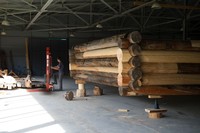
The work on the sixth restoration tier was performed in winter-spring 2013 according to the restoration technology fine-tuned in 2012. Basically, this technology includes the assembling of the unrestored tier, a detailed examination, repair of the damaged elements with the priority of preserving the authentic material (or making precise copies), test-assembling of the restored tier, preliminary tests, complying with remarks, and the submission to the acceptance commission.
Thus, upon the completion of winter period of complex restoration, an impressive restored part is well ready for just the assembling on the original site during summer period. In 2012, the underfloor section of the church was assembled, and the sixth restoration tier was set in 2013.
The 6th restoration tier was divided into three parts due to the height limits of the Restoration Complex and workforce potential of carpenters. Each of these parts was assembled, restored, examined and test-pressed according to the same technology. In April 2013, the central part of the 6th restoration tier was presented to UNESCO and Russia experts. The upper part of the 6th restoration tier was restored by June.
The most difficult problem of the preliminary assembly was a considerable deformation of log walls in vertical level, particularly in the joints of four annexes with the main building. Difference in height between originally horizontal logs was up to 0,4 meters within 5 meters of length.
These deformations appeared in first 50 years of the church life. A huge weight of the central part caused its sinkage due to lack of a rigid stone foundation, and with that, the annexes preserved their initial static position.
Even with those serious deformations, the church didn't crash thanks to a flexibility of wooden structures. The attempts to press out the central part back to the upper position with hoisting jacks as well as the other methods were not successful. The church remained in this position almost 250 years. The deformations were concealed of view by making the second layer of floors in a straight horizontal way and by remaking doorways and window openings.
The vertical deformations on the lowest 7th tier were corrected in 2012, which made it possible to correct the deformations on the upper one, the 6the tier in 2013 as well.
The horizontal deformations of log walls were also corrected. The markers of the horizontal section of the lower 7th tier were made on the floor of the assembly department during the preliminary assembly. The 6th tier was assembled on the foundation of two uppermost rows of logs of the 7th tier assembled and tested on the Pogost.
Much attention was paid to the preservation of the original materials and structural rigidity of the whole building and separate elements as well. This challenge was easily solved thanks to the methods fine-tuned in 2012, and the development of algorithm for evaluation and performance of restorers was started. The basic points of this algorithm were presented to the UNESCO and Russia experts in April 2013. They recommended continuing the development of restoration theory based on practical experience in preservation of the unique monument.
In the end of 2013, a new portion of material to be restored was delivered to the Restoration Complex, these were disassembled logs and domes of the 5th and partially of the 4th restoration tier. The restoration is going on.
3.3. The Work Performed on Kizhi Pogost. The Disassembly of Logs and Domes
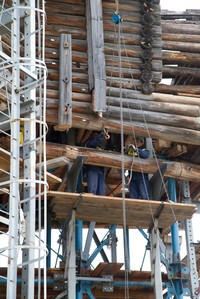
The disassembly of four domes on church annexes was done prior to the disassembly of church log walls. The specificity of church building set a new challenge of changing the disassembly direction from 'bottom to top' to the opposite one, i.e. first the disassembly of domes and, after that, of log walls.
After the domes had been disassembled, so were the log walls, carefully, in the course of three months and by the means of alifting equipment. Totally, 1,5 restoration tiers were disassembled, about 460 logs and other elements.
There were no serious difficulties during the work; however, the increased height of work area caused certain changes in work procedures. Another traditional problem was the presence of two contractors on the working sites simultaneously, i.e. the mounters, who were disassembling the log walls, and the carpenters, who were assembling the restored log walls at the same time. According to the safety rules, the simultaneous work above each other was excluded, and that caused delays. However, both of the contractors managed to keep a good pace of work and to set correct disassembly-assembly procedures that did not cause any serious stoppage of work.
In line with the Contract, the logs were not only removed from the log walls but also delivered to the Restoration Complex, washed, dried and stocked for storage.
The lifting technology has two advantages. First, the church preserves its silhouette during a long-term restoration, and, second, the portion of restored material is limited until the next summer stage of work.
The first above-mentioned point is quite clear, but the second one requires some explanations. The navigation on Onego Lake and, consequently, the delivery of materials and people lasts only 5 months a year. It is difficult to run a large-scale production in this hard-to-reach area without building a serious infrastructure, which is a really a problem on Kizhi Island. The limited amount of work material enables to keep the anthropogenic and other kinds of loads on the island eco-system within reasonable limits.
It should be noted that the gap between the logs during the disassembly has always been taken in consideration. In 2013, this gap was always kept minimum for better visual perception of tourists, as long as the disassembly of log walls and the assembly of restored logs were simultaneous and the gap left was just enough height to mount/dismount the logs.
3.4. Work on the Pogost. The Assembly of Log Walls
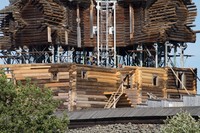
The logs and other elements restored during the winter-spring period were stocked in the Restoration Complex until summer. After the space for assembly procedures had been cleared, the assembling of log walls was started on Pogost.
Unlike 2012, when the log walls were assembled right from the ground level, the carpenters faced the same problem as the mounters had before, i.e. the increase of height of work area. In the regular course of work, the decision was made to set the external scaffolds only if extremely needed. The reason is that they are too labour and resource demanding. Actually, it was never needed because the internal metal support and the scaffolding of the refectory were used to the utmost.
The external scaffolds will be used at the assembling of domes of restored annexes. Until that moment, the carpenters prefer operating from the internal scaffolds and free outside space. This is a kind of a traditional technology because the carpenters in the old times used to work exactly inside when assembling the church, and used the outside space just for lifting up the logs.
It should be mentioned that the dimensions of the 6th restoration tier fully matched with the wooden underfloor part of the church. This is the evidence of precise measurements on the Pogost and correct marking on the floor of the assembly department in the Restoration Complex.
All deformations of two restoration tiers were fully corrected, both in vertical and horizontal sections. In other words, the church log walls were restored as they were build in 1714, and the building faults should not be repeated on the reliable foundation.
The conservation of the church for winter period proceeded after the disassembly of logs and the assembly of the sixth restoration tier.
3.5. Works on the Pogost. Completing the Reconstruction of the Church Foundation

The reconstruction of the church foundation was completed in 2013. Two restored tiers (the 6th and the 7th ones) are set on the reliable foundation. Its visible part is the imitation of the original stonework of lime mortar.
The most laborious work was matching the upper part of the foundation with the assembled portion of the wooden underfloor part of the church. Each stone of the upper part was treated manually so those to be fitted precisely to its position and to carry the church load. Usually this procedure is performed just the other way round, i.e. the building is adjusted to the foundation set, but not the foundation adjusted to the building. However, this situation was caused by the priority of preserving to the utmost exactly the log walls.
It is worth to mention once again that the main reason for church walls deformations was exactly the bad foundation of the 18th century and its sinkage. This is why a solid strip foundation of concrete was laid underground to prevent this building fault. For a better aesthetic appearance, the upper visible part of the foundation imitates the original stonework. The upper visible part of the foundation looks like a stonework.
3.6. Work Quality Evaluation, the Mission of UNESCO
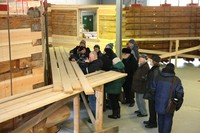
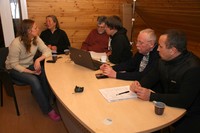
In the end of 2011, the UNESCO and Russia experts in restoration highly evaluated the activities of the Kizhi Museum in preservation of the masterpiece of wooden architecture, the Church of the Transfiguration of Our Savior.
It was reasonable to invite the next mission of UNESCO in spring, 2013 to keep in line with the production schedule and to present the work made, and so it happened.
The on-site meeting of ICOMOS mission was organized and held on Kizhi Island on the 2nd – 6th of April 2013. The Objective was supervising the restoration on the WHS. Besides the Kizhi Museum administration and personnel, the following parties participated in that meeting:
- the international experts of ICOMOS and WHC mission;
- the representatives of the Ministry of Culture of RF;
- the representatives of the Commission of the Russian Federation for UNESCO;
- the Minister of Culture of Karelia;
- the representatives of the Academy of Architecture of RF;
- the representatives of Russia design institutes and museums of wooden architecture (the architects and restorers of highest qualification grade);
- the representatives of contractors participating in the restoration of the Church of the Transfiguration.
Thanks to the restoration activities on the Church of the Transfiguration, the Kizhi Museum becomes one of the discussion platforms for the experts representing the international and Russia community of restorers. This is not the first time when a commission of qualified experts and restorers meets on the Kizhi Island to discuss the issues of restoration.
The on-site meeting participants familiarized with the complete workflow of restoration of the Church of the Transfiguration and highly evaluated the quality of work. The Kizhi Museum and contractors were recommended to keep the restoration going that direction. The method of restoration applied by the museum was fully approved.
On the 37th UNESCO session (Pnompenh, 2013), the Committee of World Heritage mentioned „the progress of the State-Party in protection and preservation of the Churches of the Transfiguration and Intercession“[1]. The Committee urges the State-Party to „keep these efforts and prevent possible losses of materials and constructive elements, which could endanger the Site.“[2]
The personnel of Museum Service for Preparation and Support of the Restoration develop their own section of the Annual Report on the Kizhi Museum Activities. This Annual Repot is submitted to the international organizations as well, such as UNESCO, ICOMOS, WHC and others.
Besides the outside control of work quality which is objectively the best one, a good performance rate is achieved by a detailed elaboration of production documentation (i.e. the project of restoration) and by the inside control of work quality by the designer and engineering supervision.
3.7. Project Development, Designer and Engineering Supervision
The restoration work procedures require that a design and estimate documentation, or more exactly production documentation, is to be developed for a work year ahead, but not for the whole scope of work. This approach has been acute until recently, however, the procedure of financing and competitive tenders got more complicated and that requires a more 'distant' project development from planning and design organizations.
A special attention is paid to the accuracy of planning and projecting and to the provision of contractors with quality documentation in required amount. Unfortunately, there were some problems with the project of complex restoration in 2013. The 'road-map' of work until 2018 was developed in 2014 to exclude such situations. This map will make it possible to organize projecting and financing without any stoppages.
In 2013, the contract with „Georeconstruktsiya“ Co ltd was signed to develop a design estimate documentation for restoration (the next stage of research and projecting work on the restoration of the Church of the Transfiguration (the central part of the lowest octagon and upper part of the annexes with 4 „barrel“ roofs and domes, ceiling beams located from 20 to 46 row of logs)). Chief architect of the project remains „Spetsprojectrestavratsiya“ Co ltd represented by architect Mr. Rachmanov and keeps operating as a subcontractor within the terms of the above-mentioned contract. The contract is valid for 2013–2014.
Two contracts were made with „Spetsprojectrestavratsiya“ Co ltd to perform a designer and engineering supervision of the restoration work on the Church of the Transfiguration on Kizhi Pogost. These two contracts carry over 2014, which enables a continuous workflow of restoration. „Stroyrekonstruktsiya“ Co ltd was contracted to control the work done on the metal ware of the lifting equipment. This company is the project designer of the lifting equipment suspending the church. The Museum Service performed the engineering supervision for Preparation and Support of the Restoration.
The projecting activities as well as the designer and engineering supervision are running all year round and subject to the work performance.
3.8. Holding Competitive Tenderings and Contract Performance
All contractors operate on the basis of contract of work and labour signed regarding the results of competitive tenders.
The following activities were performed to prepare a tender documentation for holding a Federal Acquisition Tender for the restoration of the Church of the Transfiguration:
- preparation of a primary design and estimate documentation (in collaboration with „Spetsprojectrestavratsiya“ Company);
- coordination of a design and estimate documentation with the Federal State Unitary Enterprise „Rosgossekspertiza“ (Moscow, the Ministry of Culture of RF);
- preparation of requisition notes and coordination of financing for the supposed restoration work in the Ministry of Culture of RF;
- preparation and coordination of final contractual documentation with the Kizhi Museum Finance and Juridical Services.
The personnel of the Kizhi Museum Finance and Juridical Services supervise the following issues during the whole contract time of contractors working in restoration or other fields:
- compliance of contract terms and conditions by contractors and the Kizhi Museum;
- preparation and coordination of specific finance and juridical documentation (additional agreements etc.) if contract conditions need to be amended;
- well-timed and regular submission of the contractors' report documentation for performing contractual obligations (work acceptance certificate, KC-2, KC-3 etc.);
- passage of report documentation through the Federal Treasury of Karelia and making corrections if necessary.
All contractors are certified for the performance of restoration work.
3.9. Licensing Activities
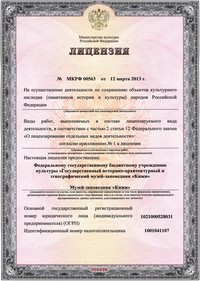
In 2013, the Kizhi Museum was granted the Licence for Performance of Restoration Work on the Cultural Heritage Sites (monuments of history and culture) with no fixed term[1]. The annual reports on restoration of the Church of the Transfiguration on Kizhi Pogost are submitted to the Department of State Control and Supervision in the Field of Cultural Heritage of the Ministry of Culture of Russia. The documentation for obtaining a yearly permission for this kind of work is issued as well.
Moscow construction college № 26 was contracted for a course of advanced training of Carpenter centre personnel. This college specializes in training of carpenters restorers of wooden architecture. A training course consisting of lectures and practical activities was held by a college teacher right in the Carpenter centre from the 16th-25th of December 2013. State-recognized certificates of advanced training were granted to 10 carpenters.
3.10. Museum Carpenter centre Activities
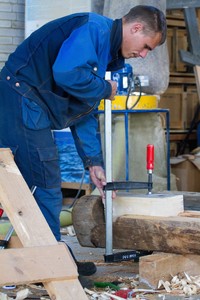
The Museum Carpenter centre keeps working. The carpenters perform quality repairs of logs and other elements of the Church of the Transfiguration all year round. The priority of preserving the original materials to the utmost and of quality work preserves more than 60% of original materials, which is a good safety index for a 300-year-old wooden building.
In 2013, the Kizhi Museum Carpenter centre shifted to a six-day workweek, which improved work efficiency. Besides that, „work-recreation“ schedule was improved for those living on Kizhi Island. All contractors and secondees on the island also work a six-day week.
Carpenters-restorers of the Kizhi Museum have been not once recognized for the high professionalism and the quality of restoration of the Church of the Transfiguration by Russian and international experts[1].
3.11. Restoration of the gild carved iconostasis of the Church of the Transfiguration

In 2013, the Kizhi Museum continued the restoration of the iconostasis frame of the Church of the Transfiguration concentrating the efforts on the Royal gates. The Moscow Art Research performed the conservation of the gild surface and Restoration Directorate (referred to below as MSRAB).
In 2014, it was planned to start the restoration of woodcarving and the frame of the Royal Gates and complete this part of the restoration with the toning of the parts with the replaced lost elements.
But at first, it is necessary to perform the test assembly of the ceiling in the Church proper of the Church of the Transfiguration. The main structural part of the ceiling (the so-called „Heaven“) is at the same time the part of the original painted iconostasis consisting of icons placed on radial transoms. The transoms paintings have not ever been conserved and are at the extremely critical conditions. Therefore, the test assembly of the ceiling is possible only after the necessary conservation of the paintings of the transoms, circular transom and friso of the original iconostasis.
In 2012–2013, a detailed examination of the integrity of the paintings of the original iconostasis elements was carried out by the MSRAB professionals and the amount and costs of works were quantified. The conservation work of the „Heaven“ painting elements is planned for the year 2014 so that the test assembly of the ceiling can be performed in October 2014. The restoration of the Holy Gates and the Alter shade can be continued in case of an additional yearly funding in 2014.
The 4years restoration process identified and aggravated the restoration problems of the interior of the Church of the Transfiguration.
For example, due to the emergency state of the gild coverage, the restoration of the iconostasis requires the strict sequence of the restoration work. It starts with the conservation of the gild coverage followed by the restoration of the frame and woodcarving and completed by the toning of the replaced lost elements.
The present conditions and specific character of the restoration process indicate that the completion of the restoration of the gild frame of the iconostasis can be declared for 2019–2020, so we may state that the restoration process runs behind the engineering and restoration schedule. To complete the restoration of the iconostasis simultaneously with the restoration of the Church in 2018 the year-round work by 8–10 high-qualified professionals is necessary. But the museum is able to organize the restoration process of the iconostasis only during warm period of the year (6 months) and the restoration workshops on Kizhi Island may accommodate only 5–6 professionals. To speed the restoration of the interior elements the working conditions on Kizhi Island needed to be improved. It is necessary to extend the restoration workshops and to create the required climatic regime inside as well as to provide the professionals with all the necessary accommodations.
3.12. Other Activities
The work on maintaining the stock of raw materials for restoration was kept on in 2013. They harvested a sufficient volume of timber to ensure the further restoration works. The Contractor is „Raduga“ (Medvezhiegorsk).
The long-term monitoring for the conditions of storage and quality of timber and carving wood stocked on Kizhi Island for the restoration of the Church of the Transfiguration as well as other museum monuments. This monitoring is conducted from May to October. The Company „Timber Experts“ Co ltd (Petrozavodsk) was contracted for performing these activities.
3.13. Future Outlooks for 2014
In 2013, the Kizhi Museum already signed the contracts that carry over to 2014 and thus organized the beginning of work since January without any delays and waiting for official Federal financing.
The competitive tenderings for the main summer-autumn activities are scheduled for the first quarter of 2014, and that will make it possible to start a large-scale work already in May. Two restoration tiers are to be restored and assembled on the Site (excluding domes) up to the end of the year. The domes are scheduled for winter period 2014–2015.
Besides the main production and restoration work, the Kizhi Museum will pay a lot of attention and time to the advanced training of carpenters-restorers and to stocking timber for restoration purpose.
